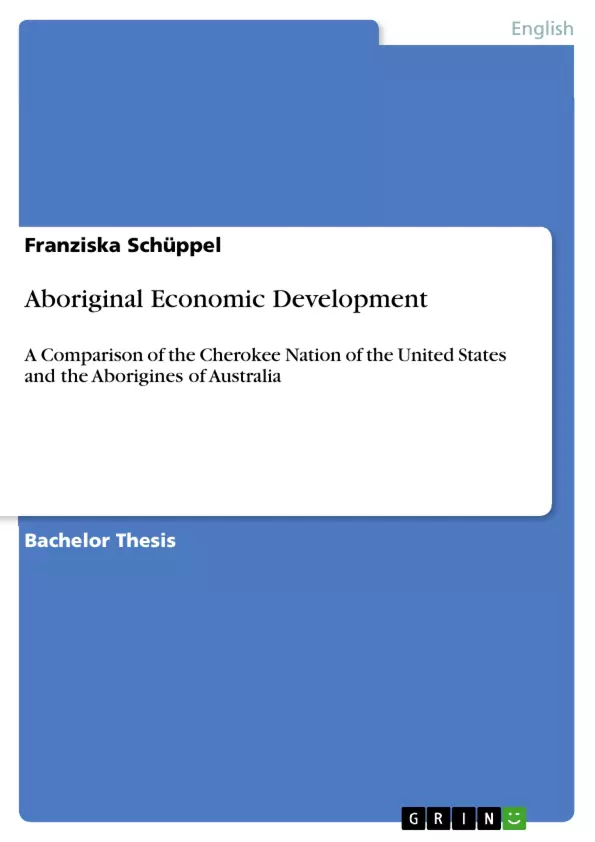Abstract
The purpose of this paper is to draw a comparison between the Cherokee Nation of the United States and the Aborigines of Australia concerning their economic development. Even though the Cherokee Nation and the Australian Aborigines share similar historical backgrounds with regard to a long lasting mistreatment by their prevailing governments, the Cherokee Nation, in contrast to the Australian Aborigines, has been and continues to experience a more successful economic development. This paper analyzes the reasons underlying this contrast. For that, the historical background of the Australian Aborigines and the Cherokee Nation is examined and compared. Since both of them were mistreated by their prevailing governments, their historical backgrounds are compared and the consequences of the mistreatment are applied to their contemporary economic situations. After that, the contemporary economic situations of the two peoples are compared, whereat the distinction between the Cherokee Nation’s economic success and the Aborigine’s economic failure becomes apparent. Finally, the reasons for the different economic development are investigated and in how far the affected peoples or even their governments, as in the case of the Australian Aborigines, are responsible for this difference. The results will be revealed and discussed.
Inhaltsverzeichnis (Table of Contents)
- Introduction
- Fateful history of the Cherokee Nation and the Australian Aborigines
- Cherokee Nation's mistreatment by the American government
- Trail of Tears
- Worcester v. Georgia
- The first years after removal
- Australian Aborigines' mistreatment by the Australian government
- Land Rights Movement
- Stolen Generations
- Policy of Assimilation
- Contemporary aboriginal economic situations
- Cherokee Nation
- Successful leader in economic development
- Reliable employer for its members
- Cherokee Nation Tribal Government
- Australian Aborigines
- Low participation in the labor force
- Tourism as the main economic source
- “Indigenous Economic Development Strategy” as attempt of improvement
- Cherokee's economic success and Aborigine's economic failure distinguishing the two historically stigmatized peoples
- Cherokee Nation's economic success
- Economic success due to adaptation to the "white" society
- Economic success due to self-government
- Economic success due to economic diversity
- Australian Aborigine's economic failure
- Social factors inhibiting their economic development
- Poor living conditions and social problems
- Discrimination
- Lacking uniform solidarity among the Aboriginal communities
- Governmental hindrance of economic development
- Inaccurate target tracking in aboriginal policies
- Reconciliation movement as attempt of improvement
Zielsetzung und Themenschwerpunkte (Objectives and Key Themes)
This paper aims to examine the economic development of the Cherokee Nation and the Australian Aborigines, highlighting the differences between their economic situations despite shared historical experiences of mistreatment. The work explores the historical backgrounds of both groups, analyzing the impact of government policies on their contemporary economic realities.
- The impact of historical mistreatment on the economic development of indigenous peoples.
- The contrasting economic situations of the Cherokee Nation and Australian Aborigines.
- The role of social and governmental factors in shaping economic outcomes for indigenous communities.
- The importance of self-governance and economic diversification for indigenous economic success.
- The challenges and opportunities facing indigenous communities in achieving economic self-sufficiency.
Zusammenfassung der Kapitel (Chapter Summaries)
The first chapter establishes the context for the study by highlighting the need for indigenous communities to advocate for their interests and improve their socioeconomic conditions. It introduces the Cherokee Nation and Australian Aborigines as contrasting examples of economic success and failure within indigenous communities.
Chapter two delves into the shared historical experiences of mistreatment by governments, focusing on key events that impacted the Cherokee Nation and Australian Aborigines, such as the Trail of Tears, the Stolen Generations, and policies of assimilation. This chapter analyzes the consequences of these historical events for the economic development of both groups.
Chapter three examines the contemporary economic situations of the Cherokee Nation and Australian Aborigines, highlighting the differences in their economic development trajectories. The chapter explores factors such as employment rates, economic reliance on tourism, and government policies.
Chapter four delves into the reasons behind the contrasting economic outcomes of the two groups. It analyzes the role of social factors such as discrimination and living conditions, as well as government policies and their impact on indigenous communities. This chapter also explores the importance of self-governance and economic diversification for indigenous economic success.
Schlüsselwörter (Keywords)
This paper explores themes of indigenous economic development, historical mistreatment, social and governmental factors, self-governance, economic diversification, and the contrasting economic situations of the Cherokee Nation and Australian Aborigines.
- Quote paper
- Franziska Schüppel (Author), 2010, Aboriginal Economic Development, Munich, GRIN Verlag, https://www.grin.com/document/207014



